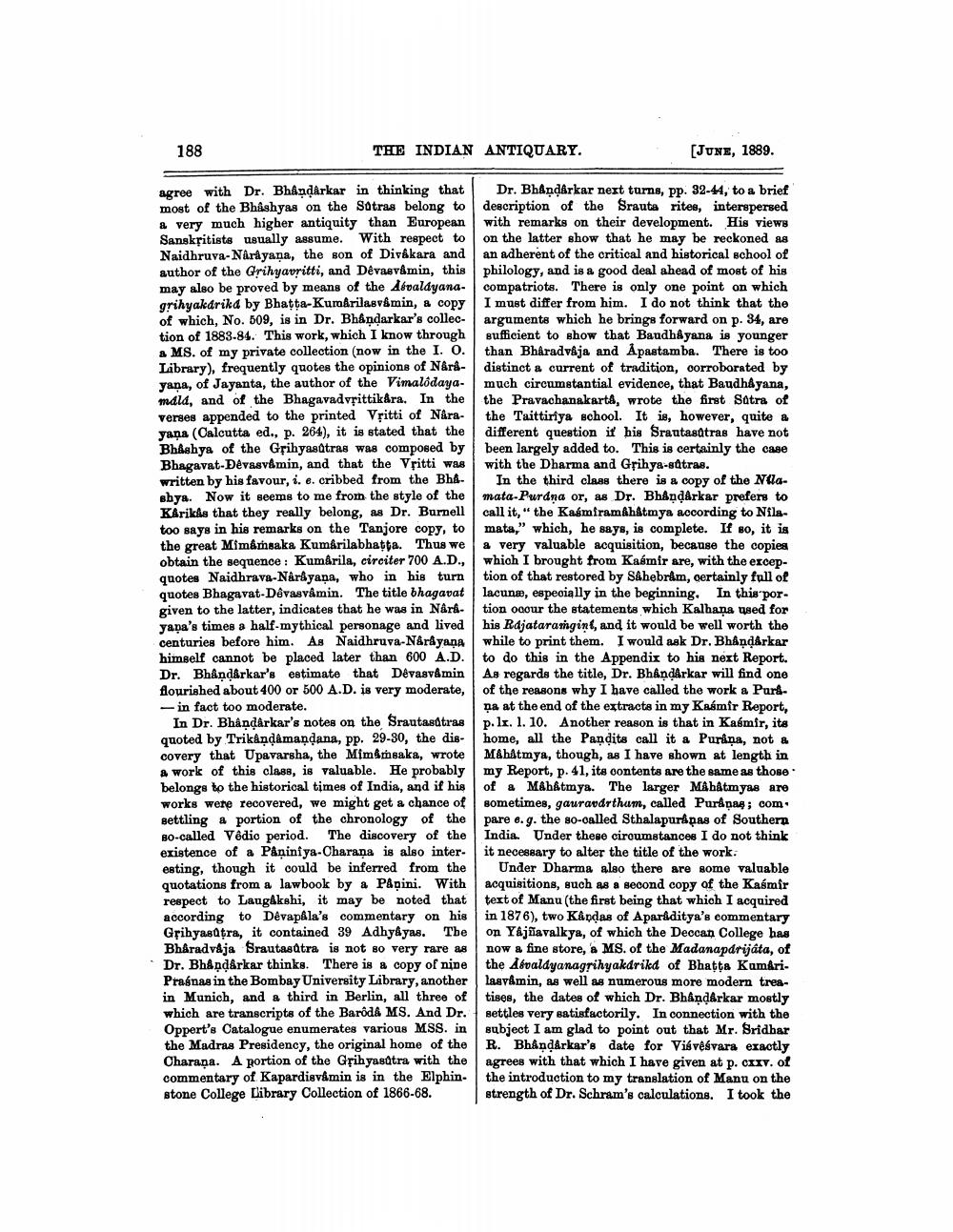________________
188
THE INDIAN ANTIQUARY.
[JUNE, 1889.
agree with Dr. Bhandarkar in thinking that Dr. Bhåndarkar next turns, pp. 32-44, to a brief most of the Bhashyas on the Sotras belong to description of the Srauta rites, interspersed a very much higher antiquity than European with remarks on their development. His views Sanskritiste usually assume. With respect to on the latter show that he may be reckoned as Naidhruva-Narayana, the son of Divakara and an adherent of the critical and historical school of author of the Grihyavritti, and Devasvámin, this philology, and is a good deal ahead of most of his may also be proved by means of the Abvaldyana. compatriots. There is only one point on which grihyakdrikd by Bhatta-Kumârilasvamin, & copy I must differ from him. I do not think that the of which, No. 509, is in Dr. Bhåndarkar's collec- arguments which he brings forward on p. 34, are tion of 1883-84. This work, which I know through Bufficient to show that Baudhyana is younger a MS. of my private collection (now in the I. O. than Bharadveja and Apastamba. There is too Läbrary), frequently quotes the opinions of N&ri
distinct a current of tradition, corroborated by yana, of Jayanta, the author of the Vimalodaya- much circumstantial evidence, that Baudh&yana, mdld, and of the Bhagavadvșittikdra. In the the Pravachanakarta, wrote the first Satra of verses appended to the printed Vritti of Nára- the Taittiriya school. It is, however, quite a yana (Calcutta ed., p. 264), it is stated that the different question it his Srautas tras have not Bh­a of the Grihyasatras was composed by been largely added to. This is certainly the case Bhagavat-Đêvasvamin, and that the Vritti was with the Dharma and Grihya-stras. written by his favour, i.e. cribbed from the Bhd. In the third class there is a copy of the Nilashy. Now it seems to me from the style of the mata-Purdna or, as Dr. Bhindårkar prefers to KÄrikhs that they really belong, as Dr. Burnell call it," the Kasmiramdhatmya according to Nilatoo says in his remarks on the Tanjore copy, to mata," which, he says, is complete. If so, it is the great Mimamsaka Kumarilabhatta. Thus we a very valuable acquisition, because the copies obtain the sequence : Kumârila, circiter 700 A.D., which I brought from Kasmir are, with the excepquotes Naidhrava-Narayana, who in his turn tion of that restored by Sahebrim, gertainly full of quotes Bhagavat-Dêvasvamin. The title bhagavat lacuna, especially in the beginning. In this porgiven to the latter, indicates that he was in Nara- tion ovour the statements which Kalhana used for yana's times a half-mythical personage and lived his Rajataramgint, and it would be well worth the centuries before him. As Naidhruva-Nárayana while to print them. I would ask Dr. Bhåndarkar himself cannot be placed later than 600 A.D. to do this in the Appendix to his next Report. Dr. Bhandarkar's estimate that DevasvAmin As regards the title, Dr. Bhandarkar will find one flourished about 400 or 500 A.D. is very moderate, of the reasons why I have called the work a Parl- in fact too moderate.
na at the end of the extracts in my Kasmir Report, In Dr. Bhandarkar's notes on the Srautasdtras p.lx. 1. 10. Another reason is that in Kasmir, its quoted by Trikåndåmandana, pp. 29-30, the dis- home, all the Pandits call it a Puriņa, not & covery that Upavarsha, the Mimmsaka, wrote Mahatmya, though, as I have shown at length in A work of this class, is valuable. He probably my Report, p. 41, ite oontents are the same as those belongs to the historical times of India, and if his of a Mah&tmya. The larger MAhâtmyas are works were recovered, we might get a chance of sometimes, gauravdrthum, called Purapag; com. settling a portion of the chronology of the pare e.g. the so-called Sthalapura pas of Southern 80-called Védio period. The discovery of the India. Under these circumstances I do not think existence of a Påņiniya-Charana is also inter. it necessary to alter the title of the work. esting, though it could be inferred from the Under Dharma also there are some valuable quotations from a lawbook by a Papini. With acquisitions, such as a second copy of the Kasmir respect to Laug&kshi, it may be noted that text of Manu (the first being that which I acquired according to Dévapâla's commentary on his in 1876), two Kandas of Aparaditya's commentary Gțihyasutra, it contained 39 Adhyâyas. The on Yájavalkya, of which the Deccan College has Bhåradvaja Srautasutra is not so very rare as now a fine store, a MS. of the Madanapdrijáta, of Dr. Bhandarkar thinks. There is a copy of nine the Afvaldyanagrihyakdrikd of Bhatta KamariPragnas in the Bombay University Library, another Lasvamin, as well as numerous more modern treain Munich, and a third in Berlin, all three of tiges, the dates of which Dr. BhåndArkar mostly which are transcripts of the Baroda MS. And Dr. settles very satisfactorily. In connection with the Oppert's Catalogue enumerates various MSS. in subject I am glad to point out that Mr. Sridhar the Madras Presidency, the original home of the R. Bhandarkar's date for Visvėávara exactly Charana. A portion of the Grihyasútra with the agrees with that which I have given at p. cxxv. of commentary of Kapardievåmin is in the Elphin the introduction to my translation of Manu on the stone College Library Collection of 1866-68. strength of Dr. Schram's calculations. I took the




